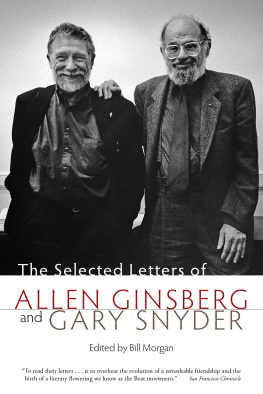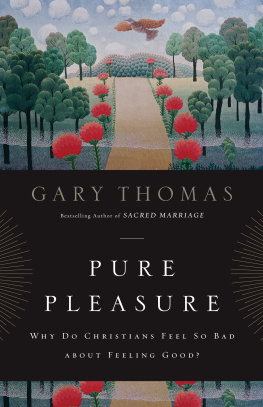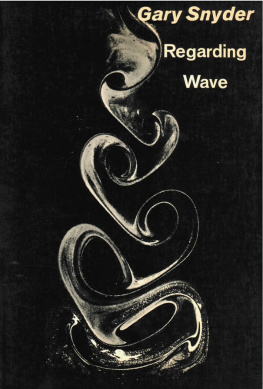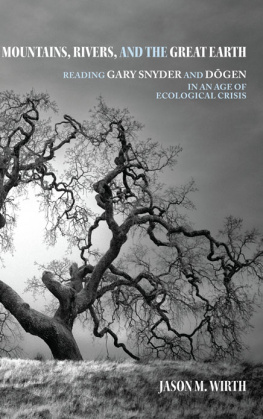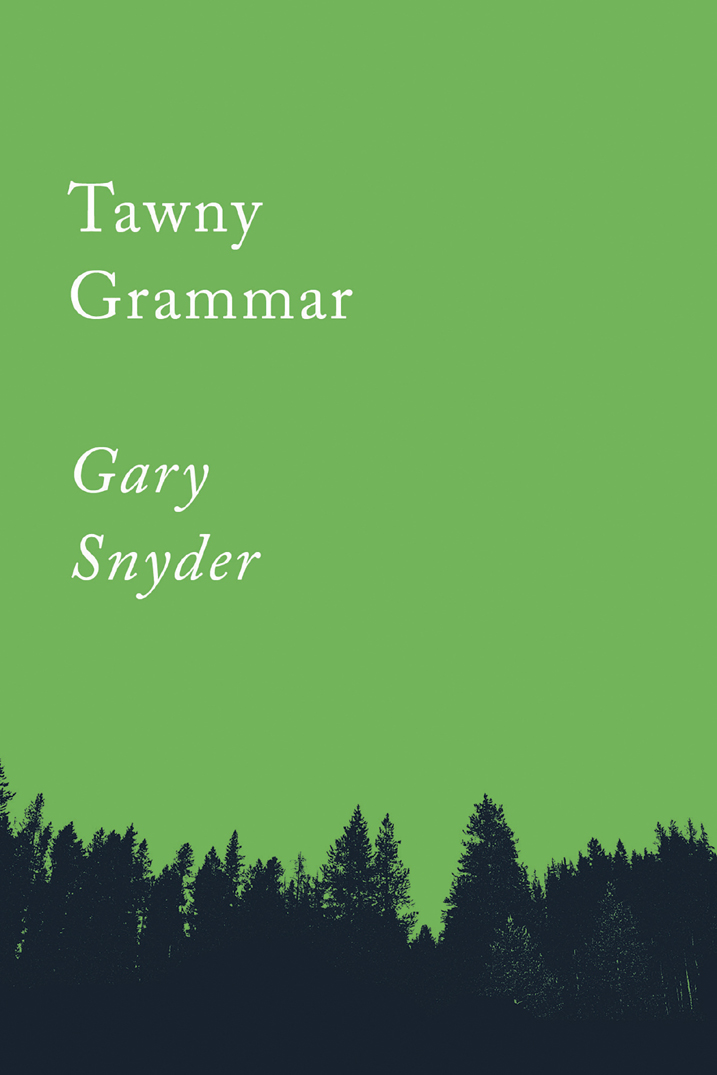Table of Contents
Guide


TAWNY GRAMMAR
Copyright 2019 by Gary Snyder
First Counterpoint edition: 2019
All rights reserved under International and Pan-American Copyright Conventions. No part of this book may be used or reproduced in any manner whatsoever without written permission from the publisher, except in the case of brief quotations embodied in critical articles and reviews.
Tawny Grammar and Good, Wild, Sacred originally appeared in Gary Snyders book The Practice of the Wild.
ISBN: 978-1-64009-175-7
The Library of Congress Cataloging-in-Publication Data is available.
Cover design by Jenny Carrow
Book design by Jordan Koluch
COUNTERPOINT
2560 Ninth Street, Suite 318
Berkeley, CA 94710
www.counterpointpress.com
Printed in the United States of America
Distributed by Publishers Group West
10 9 8 7 6 5 4 3 2 1
Contents
The Same Old Song and Dance
I WAS STANDING outside the wood-frame community hall of the newly built St. Johns Woods housing project in Portland, Oregon, on a Saturday summer eve, 1943. It pulsed, glowed, and wailed like a huge jellyfishthere was a dance going on. Most of the people who had come to live in St. Johns Woods were working in the shipyards, but there were a few servicemen home on leave, and a lot of teenagers from the high school. Most of them were from the Midwest or the South. I was from farther north, up by Puget Sound, and had never heard people speak southern before. I hung around and finally got up my nerve to go in and listen to the live band play swing and jitterbug. At some point they were playing the Andrews Sisters song Drinking Rum and Coca Cola. A girl from St. Johns high school saw me. I was a smallish thirteen-year-old freshman and she was a large gentle woman of a girl who (for what reason Ill never know) relentlessly drew me out on the floor and got me to dance with her.
I had no social confidence or experience. My usual pastimes were watching the migratory waterfowl in the sloughs along the Columbia River or sewing moccasins. The war and its new jobs had brought my family off the farm and into the city. I was first exhilarated and then terrified: as I reached around this half-known girltaller than II could feel her full breasts against my ribs. My hand settled into the unfamiliar triangle at the base of her broad back and I smelled her sweet and physical odor. I was almost overpowered by the intuition of sexuality, womanliness, the differences of bodies. I had never danced before, never held a woman. I could barely get my breath. She simply kept me moving, swinging, swaying, with infinite patience, and as I got my breath back I knew I was, now, dancing. I exulted then, knowing I could do it. It was our era, our dance, our song. I didnt dance with her again, she was soon gone with an older boy. But she had given me entry to the dance, and I had with astonishing luck passed a barrier of fear and trembling before the warmth of a grown woman. I had been in on adult society and its moment.
Each dance and its music belong to a time and place. It can be borrowed elsewhere, or later in time, but it will never be in its moment again. When these little cultural blooms are past, they become ethnic or nostalgic, but never quite fully presentmanifesting the web of their original connections and meaningsagain.
MAIZE, RICE, REINDEER, sweet potatothese indicate places and cultures. As plants they stand for the soil and rainfall, and as food sources they reflect society and its productive arrangements. Another indicator is the local song and dance. The occasion of singers, musicians, storytellers, mask makers, and dancers joining together is the flower of daily life. Not only the human is danced, but raven, deer, cow, and rainstorm make their appearance. The dance enables us to present our many human and nonhuman selves to each other, and to the place. The place is offered to itself. Art and economics are both matters of gift-exchange and the dance-offering in particular has been a proper sort of trade for the taking of fruits, grain, or game. Such giving also helps us overcome our tendencies toward stinginess and arrogance.
Every traditional culture has its dance. The young people who come to the study of dance bring their peerless perennial grace and power. They must learn to count rhythm, memorize the chants, identify certain plants, observe the seasons, absorb the gestures of animals, and to move as timely as a falcon on a stoop. Thus they are borne by their culture to become culture-bearers. The yoga of dance (as the great Bharat Natyam performer and teacher Balasaraswati called it) can be one of the paths to self-realization.
But thats only the spiritual side of it. The middle or main part is the perpetual reincarnation of a sacramental sense of the world, and dance carries that forward. Its true that many people today do not quite have their own song and dance. Current music is too much a commodity, too much in flux, it cannot dye us. We are not quite sure what our home music is. When men drink together in Japan, at a certain point in the evening they begin to take turns singing the folksongs of their home provinces. When the American in the group is called on, he has a hard time knowing what to sing. (I used to sing the quintessential ballad of Puget Sound, Acres of Clams.)
Because dance clearly has such cultural and religious significance it often comes under attack from the administrators for imperialist powersor fundamentalist preachers or ayatollahs. When missionaries went into Inupiaq Eskimo territoryon the Alaskan coast of the Bering and Chukchi seas, and the northern coast of Alaskain the last years of the nineteenth century, one of the first things they banned was dance. People there today still hunt, fish, sew mukluks, make birchbark containers, but there is no dance. A bit farther south on the Bering Sea coast is Yupik Eskimo territory. Some of the Yupik villages were missioned by the Russian Orthodox church, which did not ban dance. A dance revival has been going on in those villagesan invigorating cultural renaissance which is taking them away from TV sets and back to the community hall to rehearse and perform.
In Hawaii the political renaissance of native culture has two strong cultural poles: a renewal of interest in the traditional techniques of taro-growing and ancient or kahiku hula. The hula teachers with their schools, called halau, accept students of all races but they insist that the students master Hawaiian-language dance terminology. Students must memorize the oral epics in Hawaiian, make their own costumes, and learn how to make offerings to Laka, Goddess of Dance. Its multicultural openness makes it possible for newcomers to have an entry into the traditional Hawaiian sense of the islands.
BHARAT NATYAM, THE dance of South India, is a confluence of archaic folk tradition, court patronage, northern-derived religious devotionalism, professional temple dance-offering, and twentieth-century cultural revival. The tradition has exceptionally high standardsthe music alone is a lifetime study, the categories and qualities of gesture and expression are another study, and the accompanying drumming is a specialty of its own. The myth-derived narratives chanted to accompany certain dances evoke a vast and timeless cosmos. I didnt know all this when I first saw Padma Bhushan Shrimati Balasaraswati in a Bharat Natyam performance in Jaipur, India, in March of 1962. It was storming. We sat on the ground under a circus tent shaking in the wind, and then it began to rain in warm torrents and half the people left. The performance went on. I saw Bala act out, dance out, that moment when Krishnas mothertrying to remove the clod of dirt hes teething on from his baby mouthlooks in and sees not dirt but the depths of the whole universe and all its stars. She straightens up, backs away, in divine awe. To music. (This was Krishnas mischief on his mother.) My hair stood up.
Next page

